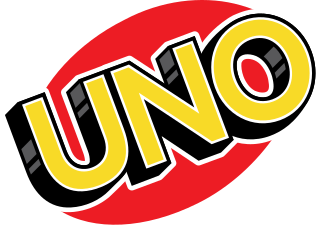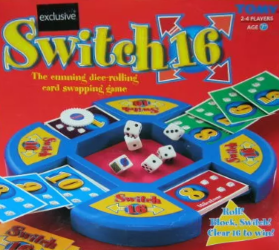Related Research Articles
Catan: Cities & Knights, formerly The Cities and Knights of Catan is an expansion to the board game The Settlers of Catan for three to four players. It contains features taken from The Settlers of Catan, with emphasis on city development and the use of knights, which are used as a method of attacking other players as well as helping opponents defend Catan against a common foe. Cities & Knights can also be combined with the Catan: Seafarers expansion or with Catan: Traders & Barbarians scenarios.

Uno, stylized as UNO, is a proprietary American shedding-type card game originally developed in 1971 by Merle Robbins in Reading, Ohio, a suburb of Cincinnati, that housed International Games Inc., a gaming company acquired by Mattel on January 23, 1992.

Memoir '44 is a light wargame or war-themed strategy board game for two players. It was created by Richard Borg and published in 2004 by Days of Wonder. Illustration done by Julien Delval and Cyrille Daujean. The game can be played with up to six players if played in teams and up to eight players in the "Overlord" scenarios. However, "Overlord" requires two copies of the game. It received the 2004 International Gamers Award for General Strategy, 2-Player category and The Wargamer 2004 Award for Excellence. The game is published in English and French by Days of Wonder.

Golf is a card game invented by Elias Clark of Brighton, England. Where players try to earn the lowest number of points over the course of nine deals.
Zombies!!! is a tile-based strategy board game for two to six players. Zombies!!! won the 2001 Origins Award for Best Graphic Presentation of a Board Game, and Zombies!!! 3: Mall Walkers won 2003's Origins Award for Best Board Game Expansion.

Bang! is a Spaghetti Western-themed social deduction card game designed by Emiliano Sciarra and released by Italian publisher DV Giochi in 2002. In 2004, Bang! won the Origins Award for Best Traditional Card Game of 2003 and Best Graphic Design of a Card Game or Expansion.

Alhambra is a 2003 tile-based German-style board game designed by Dirk Henn. It was originally published in Germany by Queen Games in a language-interdependent version; an English-specific version was released in North America by the now-defunct Überplay. The game is a Muslim-themed update, set during the construction of the Alhambra palace in 14th century Granada, of the 1998 stock trading board game Stimmt So!, which in turn was an update of the 1992 mafia influence board game Al Capone; the original version was subsequently released as Alhambra: The Card Game. Upon its release, Alhambra won numerous awards, including the Spiel des Jahres award. Its success has led to the release of numerous expansion packs and spin-off games, and is becoming Queen Games' flagship franchise.

Shadows over Camelot is an Arthurian-themed board game designed by Serge Laget and Bruno Cathala, illustrated by Julien Delval and Cyrille Daujean. The game was unveiled by the publishers Days of Wonder at the 2005 American International Toy Fair and was more widely released in May and June 2005. The game was also published in French as Les Chevaliers de la Table Ronde and in German as Schatten über Camelot. In 2008, an expansion for Shadows over Camelot was released titled Merlin's Company.

Arkham Horror is a cooperative adventure board game designed by Richard Launius, originally published in 1987 by Chaosium. The game is based on Chaosium's roleplaying game Call of Cthulhu, which is set in the Cthulhu mythos of H.P. Lovecraft and other horror writers. The game's second edition was released by Fantasy Flight Games in 2005, with a third edition in 2018.
Minion Hunter is a board game published in 1992 by Game Designers' Workshop in conjunction with their Dark Conspiracy role-playing game. The game is designed to encourage the players to work cooperatively to stall or defeat the plans of four Dark Minion races as a primary goal, with individual advancement a secondary objective.
I'm the Boss! is a board game by American designer Sid Sackson. It is a negotiation game in which a group of players compete and cooperate to put together profitable business deals. The goal is to make the most money. I'm the Boss is currently published by Gryphon Games, after the Face2Face Games edition. It was previously published as Kohle, Kies & Knete.

Uno is a video game based on the card game of the same name. It has been released for a number of platforms. The Xbox 360 version by Carbonated Games and Microsoft Game Studios was released on May 9, 2006, as a digital download via Xbox Live Arcade. A version for iPhone OS and iPod devices was released in 2008 by Gameloft. Gameloft released the PlayStation 3 version on October 1, 2009, and also released a version for WiiWare, Nintendo DSi via DSiWare, and PlayStation Portable. An updated version developed by Ubisoft Chengdu and published by Ubisoft was released for the PlayStation 4 and Xbox One in August 2016, Microsoft Windows in December 2016 and for the Nintendo Switch in November 2017.
A number of related games under the Yahtzee brand have been produced. They all commonly use dice as the primary tool for game play, but all differ generally. As Yahtzee itself has been sold since 1954, the variants released over the years are more recent in comparison, with the oldest one, Triple Yahtzee, developed in 1972, eighteen years after the introduction of the parent game.
Merillian is a US company that makes board games, including the build-a-board game set Flibbix and the Flibbix Puzzler iPhone-optimized web game. It is located in the Puget Sound near Seattle in Duvall, Washington and was founded in 2006 by CEO Jason Ivan.

Last Night on Earth: The Zombie Game is a survival horror board game that was first published in 2007. Players can play on the Hero team or as the Zombies. A modular board randomly determines the layout of the town at the start of each game and there are several different scenarios to play. Seven supplements have been released.

Qwirkle is a tile-based game for two to four players, designed by Susan McKinley Ross and published by MindWare. Qwirkle shares some characteristics with the games Rummikub and Scrabble. It is distributed in Canada by game and puzzle company Outset Media. Qwirkle is considered by MindWare to be its most awarded game of all time. In 2011, Qwirkle won the Spiel des Jahres. A sequel, Qwirkle Cubes, was released by Mindware in 2009.
Terakh is a board game produced by Stoneplay and originally released in 2005. The game is named after its Canadian inventors Terence Wong and Akhil Patel.

Switch 16 is a children's board game published by Tomy in 2001.
The Genius: Black Garnet is the third season of The Genius. It debuted on tvN on October 1, 2014.

Cartographers is a roll and write board game designed by Jordy Adan and published in 2019 by Thunderworks Games. It is part of the Roll Player universe. In the game, players aim to draw terrains based on drawn cards that award points based on the relevant letter cards. The game received positive reviews, and was nominated for the Kennerspiel des Jahres, but lost to The Crew. It was also runner-up to Parks for the Best Family Game of the 2019 Board Game Quests Awards. An app for solitary play was released in 2020.
References
- ↑ "Merillian Flibbix Page". Archived from the original on 2008-08-20. Retrieved 2008-07-17.
- ↑ "Merillian Board Blender Page". Archived from the original on 2008-07-05. Retrieved 2008-07-17.
- ↑ "Merillian Rule Roundup Page". Archived from the original on 2008-07-05. Retrieved 2008-07-17.
- ↑ National Parenting Center Gives Flibbix Seal of Approval
- ↑ "Flibbix Wins NAPPA Gold Award". Archived from the original on 2008-11-20. Retrieved 2008-07-17.
- ↑ "Flibbix Wins Parents' Choice Award". Archived from the original on 2009-08-01. Retrieved 2008-11-03.
- ↑ Mom's Best Network give Flibbix Mom's Best Award
- ↑ "Merillian Press Page". Archived from the original on 2008-11-20. Retrieved 2008-07-17.
- ↑ Toy Directory Monthly gives Flibbix Innovations 2008 Award
- ↑ TD Monthly's Top 10: Game Zone List
- ↑ "Flibbix Puzzler". Archived from the original on 2013-01-15. Retrieved 2017-09-09.